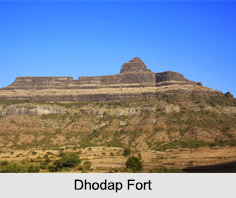 Dhodap Fort is a hill fort in the Nashik district of Maharashtra. Standing at an elevation of about 4829 feet, Dhodap Fort is the second highest fort in the Sahyadri Mountains after Salher Fort. Dhodap hill is the third highest hill peak in Maharashtra after Kalsubai and Salher and the 29th highest peak in Western Ghats. Dhodap Fort is a good site for trekkers and adventurous tourists to visit. The base village is called as Dhodambe from where one can start to climb the Dhodap Fort.
Dhodap Fort is a hill fort in the Nashik district of Maharashtra. Standing at an elevation of about 4829 feet, Dhodap Fort is the second highest fort in the Sahyadri Mountains after Salher Fort. Dhodap hill is the third highest hill peak in Maharashtra after Kalsubai and Salher and the 29th highest peak in Western Ghats. Dhodap Fort is a good site for trekkers and adventurous tourists to visit. The base village is called as Dhodambe from where one can start to climb the Dhodap Fort.
History of Dhodap Fort
According to historical sources, Dhodap Fort played an important role during the Peshwa period. The historical Battle of Dindori was fought in this fort. It is also said that Raghobadada Peshwa hatched a plot against Madhavrao Peshwa in this fort. During return travel from the second invasion from Surat, Chatrapati Shivaji had visited this fort for keeping the treasure.
Structure of Dhodap Fort
Dhodap Fort is recognizable for its typical shape. The top of the fort was built using a combination of dressed stone and brickwork. There is a tank with an idol of Lord Hanuman and a tunnel 5m wide. The fort has a pointed cliff named "Shembi". One can find caves at the base. One end of the fort shows a domical structure. The eastern face shows a fearsome cliff named "Ikhara" which is ideal for rock climbers. There is also a trunk in the cave which is in a good condition at present.
Local Beliefs in Dhodap Fort
One of the most interesting things is that there is a "cow of stone" moving inside this hill. It"s heard by the people in the nearby villages that on every "Vasubaras", this cow moves inside by the distance of four grains.
Visiting Information of Dhodap Fort
Dhodap is close to Mumbai and travellers from Mumbai can get to this fort in 6-7 hours. The fort is 55km to the Nashik, about 3km from Hatti village, 16km from Abhona in the Satmala range, Nasik region of Sahyadris. When travelling from Nashik to Malegaon on National Highway 3, one can see this fort from a distance.



















